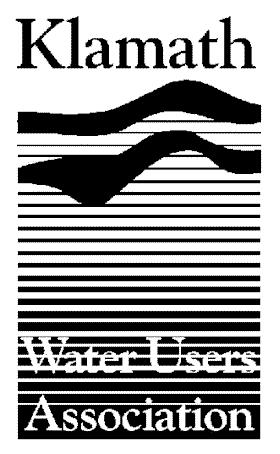
Klamath Water Users Association
Response to Klamath River
Basin
Conservation Implementation Program
|
|
Klamath Water Users Association Response to Klamath River
Basin
|
|
Klamath Water
Users Association 2455 Patterson Street, Suite 3 Klamath Falls, Oregon 97603 (541)-883-6100 FAX (541)-883-8893 kwua@cdsnet.netAugust 15, 2003 Christine Karas Re: Klamath River Basin Conservation Implementation Program Dear Ms. Karas: On behalf of the Klamath Water Users Association (KWUA), I would like to thank you for you providing us with the opportunity to express our concerns regarding the draft Conservation Implementation Program (CIP) document prepared by the U.S. Bureau of Reclamation (Reclamation). KWUA is a nonprofit corporation that has represented Klamath Irrigation Project farmers and ranchers since 1953. Our members include rural irrigation districts and other public agencies, as well as private concerns operating on both sides of the California-Oregon border. KWUA focuses on issues that affect thousands of people dependent on the Project, including farm and ranch families, local businesses, and our rural communities. KWUA and its members also play an important role in Klamath Basin wildlife conservation activities, including efforts to provide environmental water to two national wildlife refuges. General Overview We appreciate the time and effort you and Reclamation staff have put forth to develop the draft CIP. We hope that you will consider our comments in the constructive manner in which they are intended. The CIP is intended to serve as a mechanism by which the participants can implement actions necessary to achieve recovery. Klamath water users are interested in assessing how this program could be implemented in the Klamath Basin, where current Endangered Species Act (ESA) water management decisions are driven by Biological Opinions that provide no objectives, mileposts, or agency accountability to actually recover listed fish. While we are hopeful that that such a program modeled after the Colorado River effort might provide improved regulatory and economic certainty, we also acknowledge that contentious tribal trust and looming water quality issues would complicate initial progress for this program. Putting these broader issues aside, we offer the following comments for your consideration. Key Concerns Communication and Coordination: A key to the success of the CIP will be for its program managers to assess ongoing and proposed watershed restoration and fish recovery programs, and – with stakeholder input - determine how existing stakeholder / agency forums might be folded into the new CIP governance structure. As you know, many existing programs and groups may feel threatened if they view the CIP philosophy as a "top down" approach. While the draft CIP states that it is not intended to supplant any of these existing efforts, we recommend that you prioritize initial outreach with these interests. As you review these comments and those submitted by other parties, you might consider releasing a "modified draft" that you personally deliver to other Klamath forums to demonstrate your willingness to consider and reflect efforts that are already underway. This may provide an initial assurance and justification for the CIP’s claim to emphasize close communication and coordination with other efforts. Purposes of the CIP: We preliminarily support the two primary purposes of the CIP:
We believe that these two purposes must be supported by a philosophy that does not redirect or impose significant impacts or costs to any one sector of the watershed. Additional Information to Assist the CIP: The draft document notes that the recovery plans for the shortnose and Lost River suckers were completed by the U.S. Fish and Wildlife Service in 1994, based on the best available information at the time. Significant new information has been developed since 1994, and we support the draft CIP’s premise that the recovery plans should be updated. Additional documents that should be considered in this effort include:
Many of the guiding principles contained in the documents prepared by our association have also been implemented with success through the Ecosystem Restoration component of the CALFED Bay-Delta Program, a massive ecosystem-based program underway in California’s Central Valley. List of Accomplishments - The CIP proposes to simultaneously implement actions to improve habitat while a long range plan is being developed, thereby initially accumulation a list of accomplishments. As an initial step, we believe it is critical to recognize the considerable restoration work that has already been accomplished in the Upper Klamath Basin. We request that you refer to KWUA’s Summary of Environmental Restoration and Water Conservation Efforts Undertaken by Klamath Water Users Association (KWUA) & Landowners (January 2003) as a starting point in this effort. CIP Participants – Some of the individual irrigation and water districts who are members of our association have expressed concern that the CIP only provides opportunities for representation via KWUA. We recommend that further representation for project districts and other agricultural interests (including non-Project irrigators and county commissioners and supervisors) be provided in a manner that balances the representative base proposed for tribal interests. Decision Making Process - It is not clear from the draft document how decision-making will occur. Consensus is emphasized, but voting is also proposed. Additional clarification is required in this section. Thank you for your consideration of our comments. If you have any questions or concerns about this letter, please do not hesitate to call me at 541-883-6100. Sincerely,
Dan Keppen Executive Director
|
|
Klamath Water Users
Association |
Content and Logo: Copyright © Klamath
Water Users Association, 2002 All Rights
Reserved
Page design: Copyright ©
klamathbasincrisis.org, 2002, All Rights
Reserved